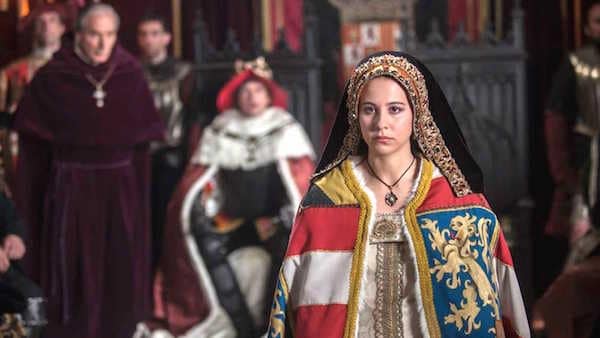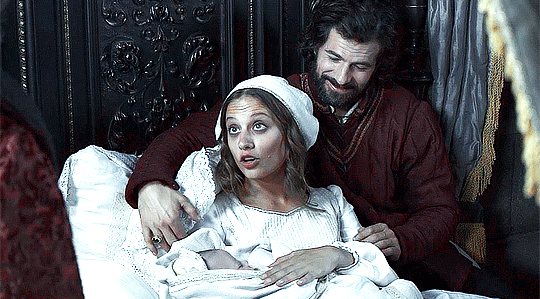

Her husband was influenced by deceitful, unscrupulous advisors. The life Juana had built in Flanders crumbled as everyone around her scrambled to exploit any and every possible political advantage. But everything changed when, through a succession of family deaths, Juana became direct heir to the Spanish throne she suddenly saw an ambitious, calculating, even cruel side of her dashing husband. Initially resistant to the marriage, Juana eventually fell in love with Philip and resigned herself to life in Flanders, outside her beloved Spain. Her parents arranged a marriage between Juana and Philip the Fair, Hapsburg heir and archduke of Flanders. In 15th century Europe, royal children were betrothed in marriage not for love, but to facilitate political alliances. Ferdinand and Isabella passed their passion and fierce nationalism on to at least one of their four daughters: from childhood, Juana harbored an intense loyalty to her native land. Juana has never known life apart from the crusades and her parents' all-consuming dedication to uniting Spain and expelling the Moors. Her parents, Ferdinand and Isabella, have just conquered Grananda, ending 300 years of Moorish rule. The novel opens in 1492 when Juana is 13 years old.

Gortner proves that Juana's story is just as complex and captivating as that of her more famous younger sister. But few people know about Juana of Spain, also known as Juana la Loca, sister to Henry VIII's first wife Katherine of Aragon.
#JUANNA LA LOCAD CHILDHOOD SERIES#
During the rebellion of August 1520 her keepers claimed that she had been oppressed, detained by force and imprisoned for 14 years as though she had not been sane and she was evidently capable of speaking freely, with prudence and judgement.The Tudors of England have enjoyed surging popularity in the past year, with a hit Showtime series and Philippa Gregory's acclaimed historical novel The Other Boleyn Girl, which was adapted to the big screen last winter. She never expressed interest in visiting the tomb at Santa Clara.

Ferdinand dismissed her servants and appointed a custodian accountable to him alone, a practice sustained by her son Charles: Juana was isolated, deceived, deprived, tortured and endured appalling conditions. She visited her sister – later Catherine of Aragon – in England around October 1507, when there is no mention of mental illness. On 14 January 1507 she gave birth to her daughter Catalina and there are no indications that she was restricted in childcare. Ferdinand originated or countenanced the rumour that Juana did not believe in the death of her husband.

She rests in the Royal Chapel of Granada.Īlternatively – history is a fickle informant – independent correspondence does not indicate madness at Philip's death, or any subsequent symptoms of serious mental illness. Queen until death, Spain evolved from the union of her crowns. The cadaver was placed at the nearby convent of Santa Clara. Ferdinand ‘retired’ her and from February 1509 confined her to the fortified palace at Tordesillas. She opened the coffin to gaze at and talk to her beloved. When the coffin was reopened, she embraced and kissed the body. She allowed burial but had the remains exhumed. The corpse travelled with her, even from dinner table to bedside. She would not part with Philip's embalmed body, believing it still lived, watching with affection as if it were alive. Juana's reason gave way and she never recovered. In August 1506, Philip died suddenly of typhoid – or poisoning by Ferdinand. Later the same day Ferdinand revoked this agreement, which was prejudicial to his interests and (he said) obtained by force. In June 1506, father and husband cited ‘infirmities and sufferings, which for the sake of her honour are not expressed’ in a treaty leaving the government of Castile to Philip. Queen of Castile from 1504, around February 1505 the Cortes (parliament) was informed of Juana's unspecified ‘infirmity’, presumably by Ferdinand, and legitimised his right to administer Castile. He was unfaithful, cruel, intimidated and impoverished her, squandering her funds her response was marked by jealousy, rage and violent behaviours: throwing herself against the wall in despair and hacking off a rival's hair and stabbing her in the face. Her parents established the Spanish Inquisition, which coloured her childhood: at her mother's behest she was tortured for religious rebellion. Juana was imprisoned for nearly 50 years, her right to regal power usurped in manoeuvrings by her mother Isabella I, father Ferdinand II, husband Philip I ‘the Handsome’ and son Charles I (Charles V, Holy Roman Emperor).


 0 kommentar(er)
0 kommentar(er)
